|
Saturday the 12th I
got up moderately early and went down to Serpentine Fen, a nature
reserve in south Surrey, just up the river from Mud Bay. I'd been
to the fen before, but I'd never actually walked around the whole
reserve. This day, I was resolved to do just that.
One ulterior motive
I had was that people had reported a few Greater White-fronted
Geese from the fen recently, and I've been hoping to get good
photos of some of them.
When I entered the
park around 8:30, I immediately noticed a Double-crested Cormorant
in the river. He dove down and came back up with a fish. I started
clicking away. For the next little while, I watched the cormorant
doing various things with this fish, like tossing it up in the
air a little.
|
|
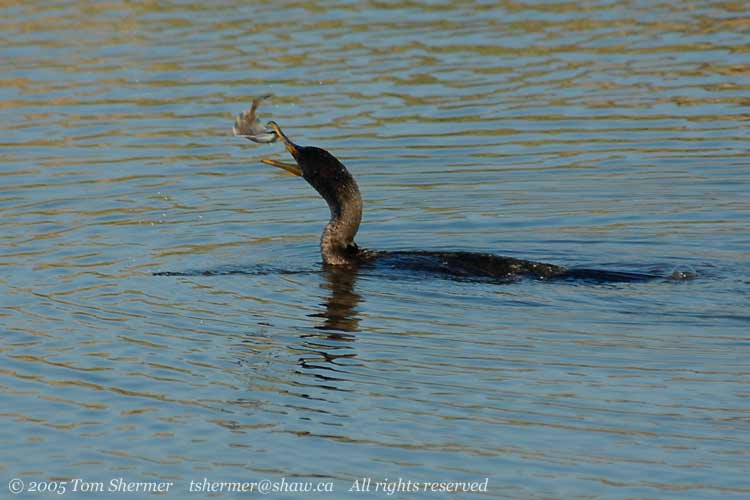 |
| And catching
it, pulling down hard to flex the fish's body. |
|
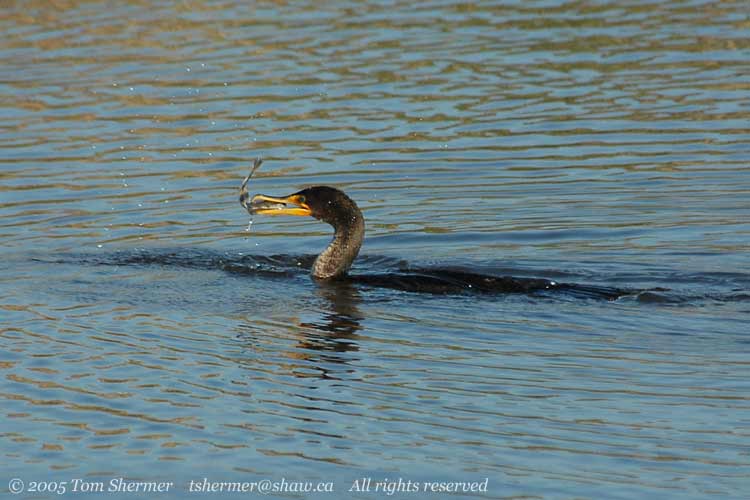 |
| He jerked
his head this way and that, throwing the fish around quite violently. |
|
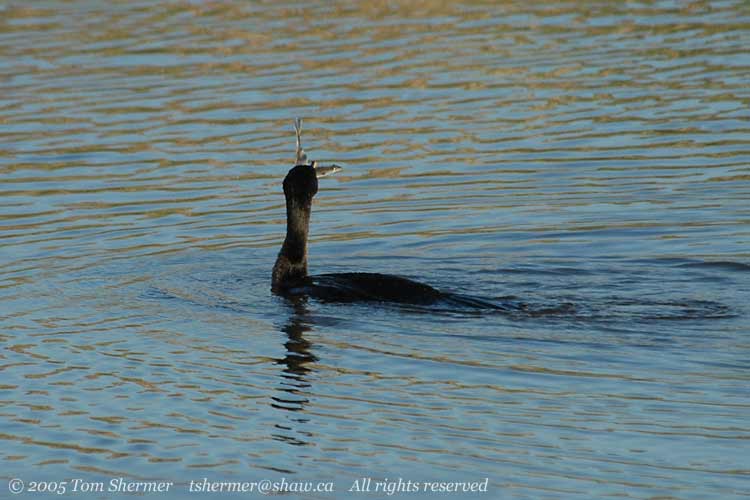 |
|
As you can just make
out in the previous photo, or perhaps percieve better in this
detail below, the fish has two eyes on one side and is thus a
flatfish, mainly an inhabitant of the bottom of the river.
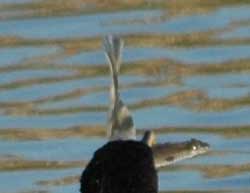
This particular flatfish
is called a Starry Flounder. The yellow and black stripes all
around it on the fins give it away.
Starry Flounders have
white undersides.
|
|
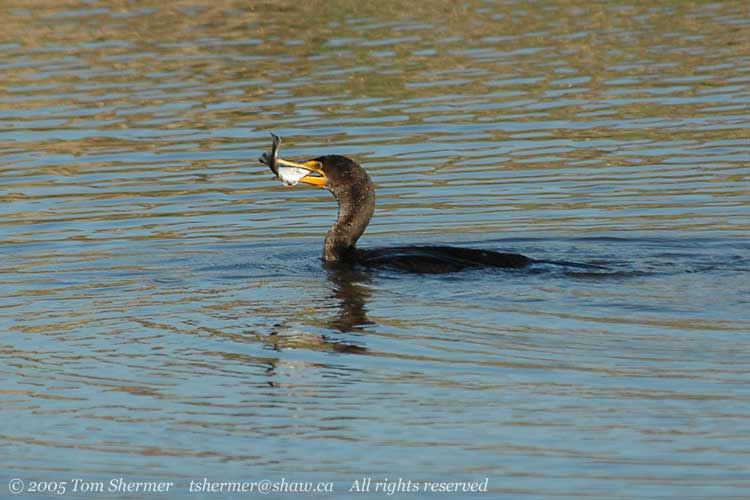 |
| They also
apparently taste good: finally the cormorant tossed the fish up,
and sent it down the hatch. Here just the tail is hanging out of
his mouth. |
|
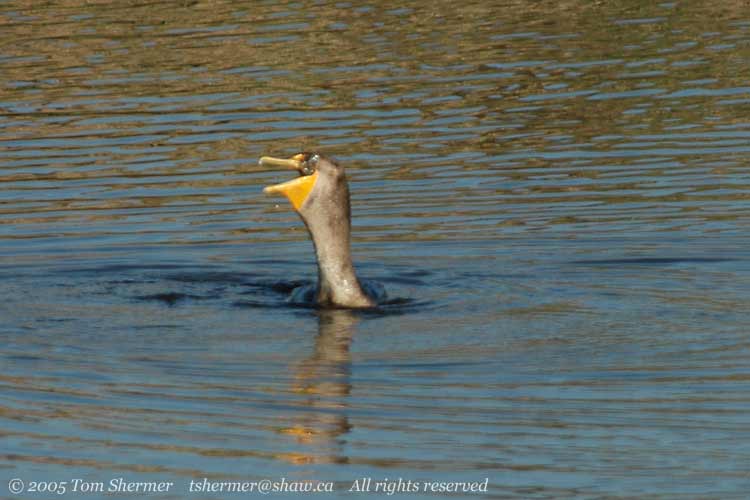 |
|
Anyhow, if I find that
cormorant's mother, I'm going to have a word with her about teaching
her children not to play with their food.
I watched the cormorant
until he had swallowed the fish (his throat was bulging for a
while until he got his meal all the way down). Then I headed on
as he went fishing for more.
Next I encountered
a youngish Bald Eagle in a small tree by a fork in the path. I
guess when you're at the top of the food chain, you can afford
to get some shuteye even when you're sitting out in the open.
|
|
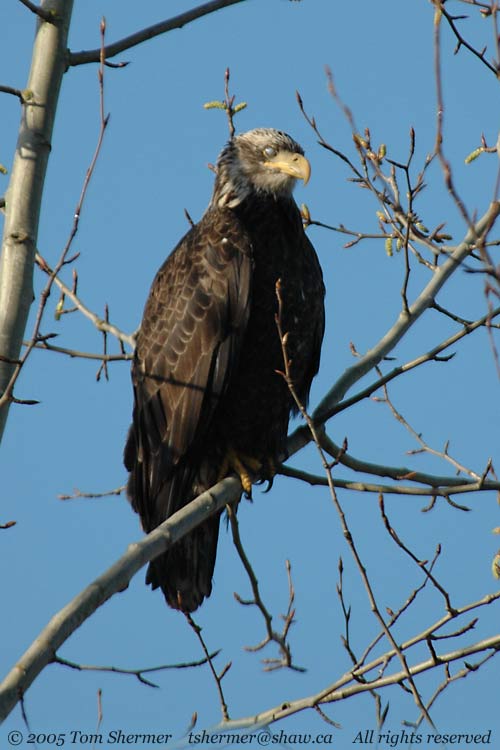 |
| I headed
left at the fork, away from the river, and found a small flock of
geese. I checked each one and they were all Canadas—no Greater
White-fronted. I turned to go on and noticed a Northern Harrier
cruising over the field on the other side of the path. |
|
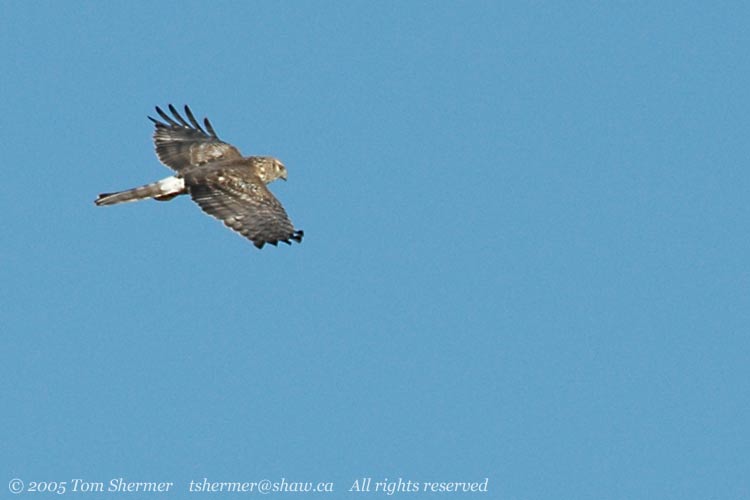 |
| I walked
another twenty meters or so, and then I heard the machine-gun repetition
that marks the song of wrens. In this case, it was a Marsh Wren.
That was fitting, as I was in a marsh. There were at least seven
or eight of the little guys in the area. Unfortunately, they were
backlit, and this early in the morning the sun was still pretty
low. Here's a shot of one of them on some marsh grass. |
|
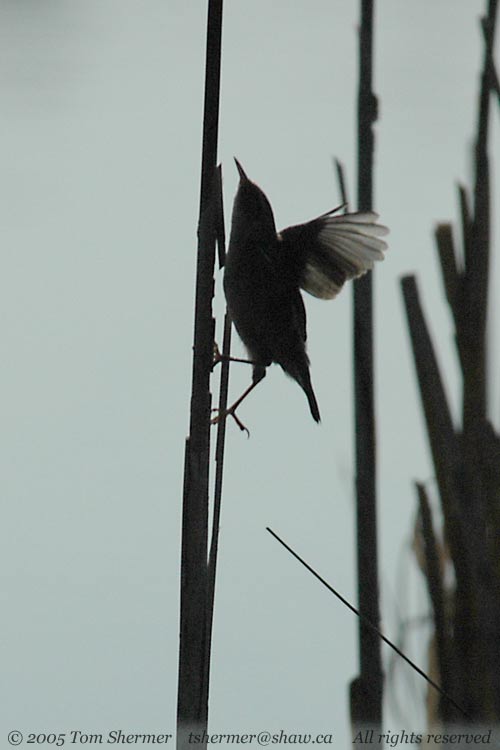 |
| And here's
the best-lit shot I was able to get. It was nesting time for the
wrens, and they were gathering nesting material from the cattails. |
|
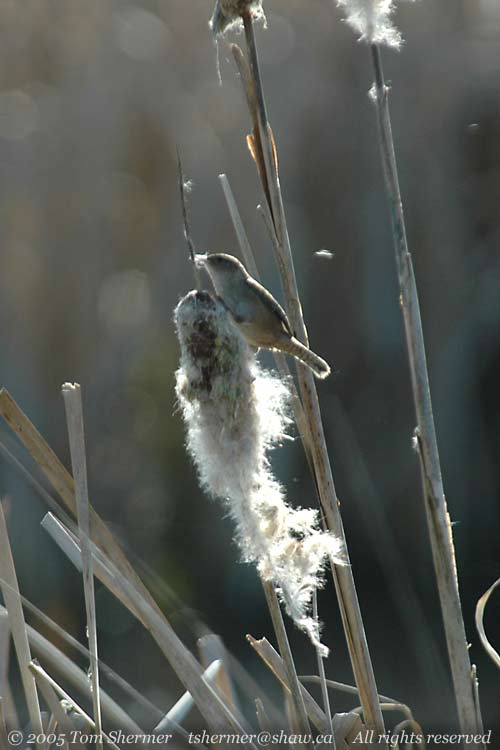 |
| I watched
them gathering their materials for a while, and then got distracted
by a squawking Great Blue Heron that flew over. I never thought
about it before, but I guess that their having a long bill implies
that they have a long tongue. |
|
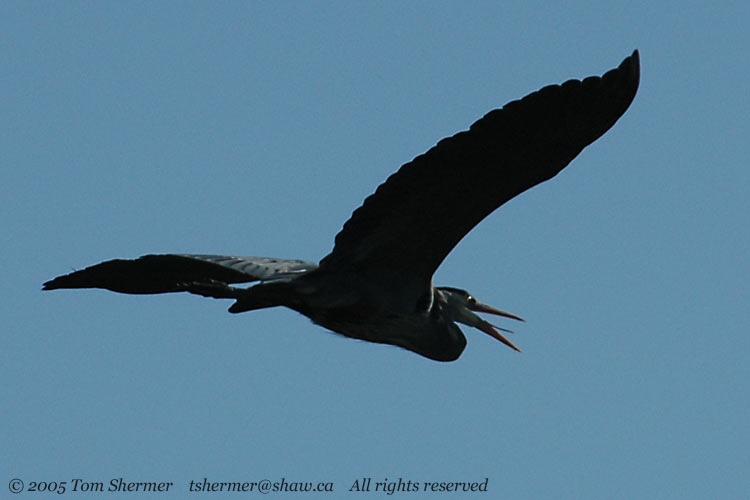 |
| I continued
on, past a viewing tower and then on to a path that headed back
towards the river. I saw a few Red-winged Blackbirds, and then an
American Wigeon flew past, landing in the marsh a fair ways away.
I was taking photos of the wigeon, but changed subjects when I saw
that he had landed near a Ring-necked Duck. The Ring-necked is the
guy on the right; this is as close as I was able to get to him.
|
|
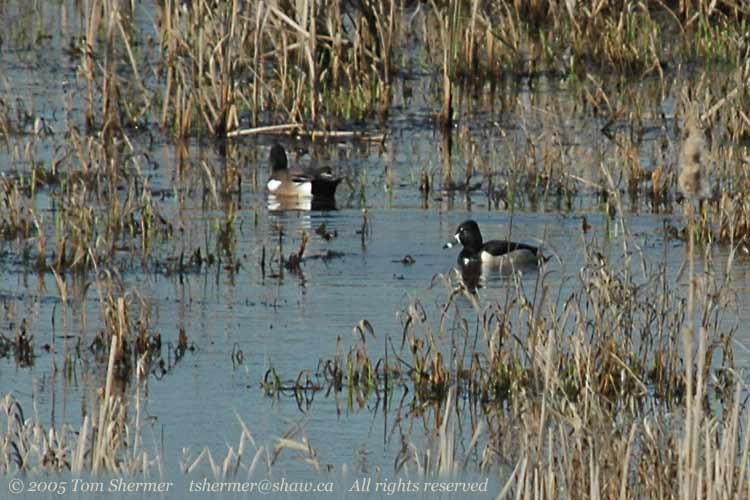 |
|
I've found Ring-neckeds
to be pretty shy, and have yet to get really good, close photos
of them. But I'll keep trying.
I reached the river,
and headed south for a few minutes to close to the highway bridge
and end of the reserve. I then doubled back and followed the river
for the rest of my walk.
There were many ducks
along the river, including Red-breasted Mergansers, Common Goldeneyes,
Gadwalls, Buffleheads, Green-winged Teals, American Wigeons, and
Scaup (both kinds, I think). One group of Greater Scaup kinda
up and flew past me as I approached them. I got several shots
of them flying past. Here's one, showing two females.
|
|
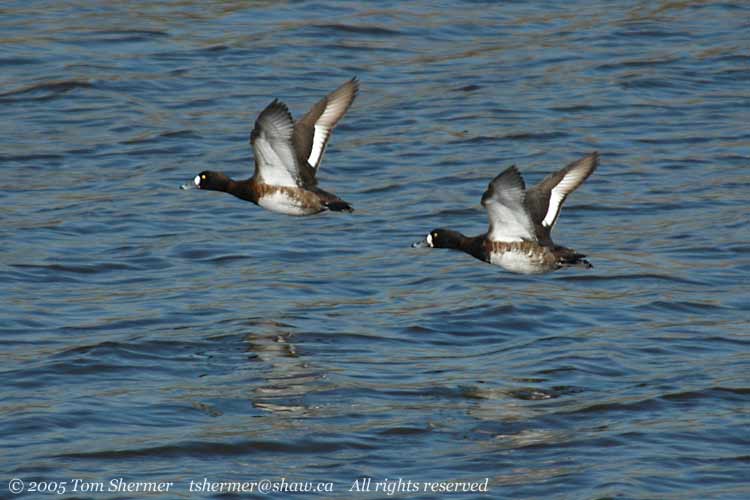 |
| About five
minutes later, I encountered this gentleman, who I believe is a
Lesser Scaup. He's in the grips of a religious experience; just
moments before I took this photo, manna had in fact been falling
from heaven. Very tasty manna, at that. |
|
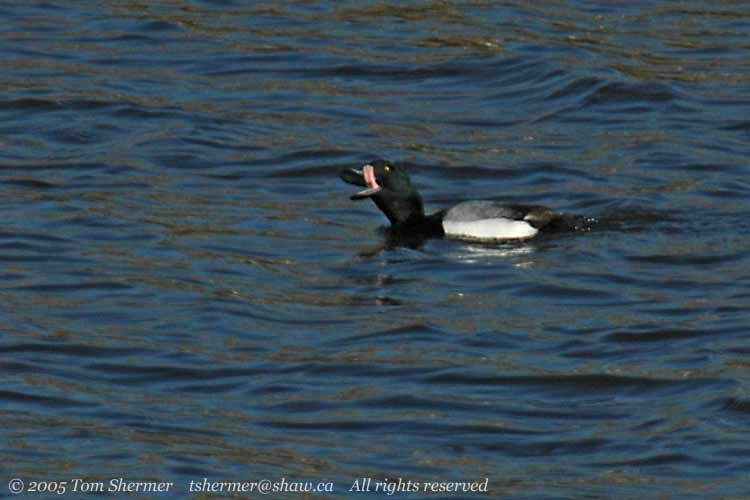 |
|
It was now about 10:30
and I was nearing the parking lot again. I again checked for Greater
White-fronted Geese but found none. Both the eagle and the cormorant
were where I had found them earlier, and I took a few shots of
each before getting in my car and heading on.
For my next stop, I
chose the Tsawassen ferry terminal. Cormorants were gathered on
the far side of the compensation lagoon, as they often are. The
lagoon itself was underwater due to the tide being quite high.
|
|
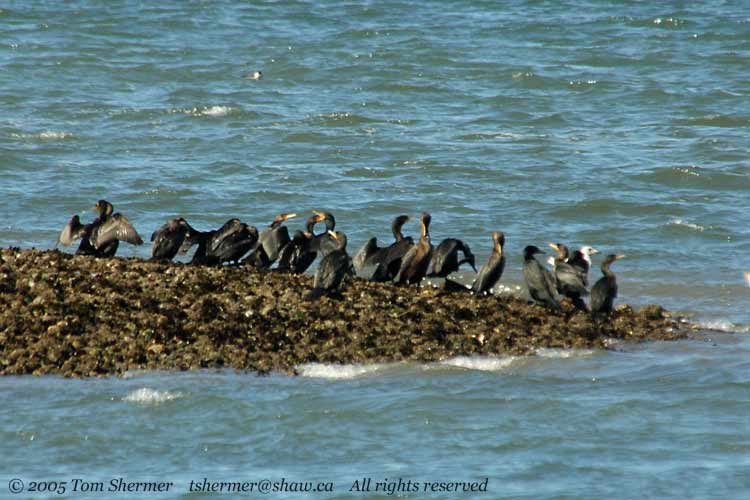 |
|
Since cormorants were
about all there were at the lagoon, I headed to the other side
of the terminal to see what was hanging out near berth one. Most
of the regulars were there, so I sat down and had a chat with
them.
I ended up swapping
stories with a Horned Grebe; he was a fan of children's tales.
I told him Hansel and Gretel (birds always like that breadcrumb
thing) and he told me The Three Little Pigs. He really got into
it, imitating just how that old wolf huffed and puffed.
|
|
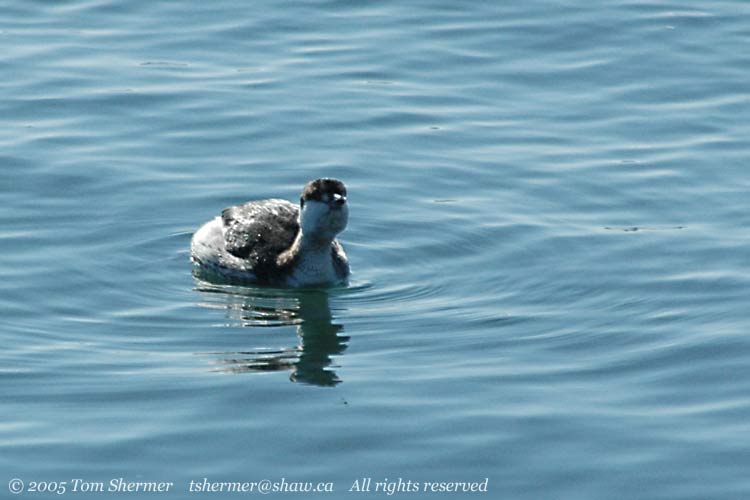 |
| The grebe
wanted another round of stories, but I had to take my leave, as
I wanted to see who else was around. I walked down the side of the
terminal, and found a gull who also seemed to have lunch on his
mind. |
|
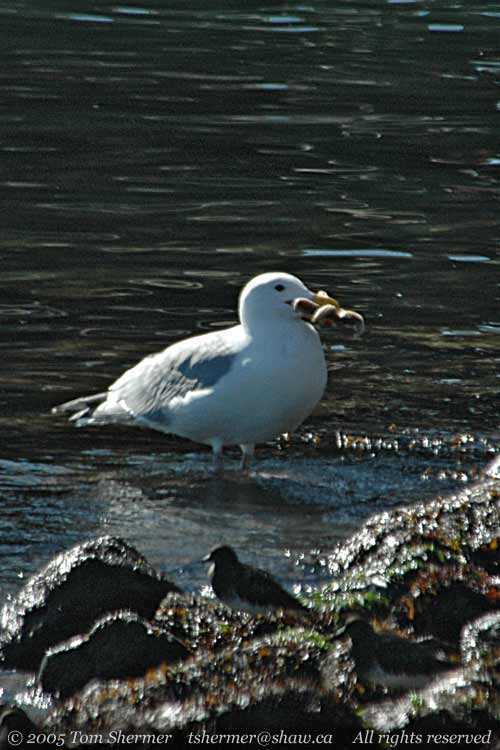 |
|
That's a starfish that
the gull is carrying; I have never seen any bird with a starfish
in its mouth before. I didn't think they were good eatin', but
then again, I'm not a gull. It sure struck me as odd, though.
Out of focus, in the
foreground of the previous photo, is a Black Turnstone. Black
Turnstones are average-sized shorebirds, much bigger than peeps
(the little shorebirds). That means that that gull is pretty darned
big. It's easy to forget how massive gulls really are.
All that pondering
about what gulls eat got me wondering about what I was going to
eat, so I headed off to Ladner to answer that question (It ended
up being a burger with a salad, if you must know.). Afterwards,
I went by Beach Grove to see what was shakin' there.
I headed towards the
bay; I'd never been to the dyke from this end before, and figured
I'd go have a look. On the way, by the side of the road, I saw
a butterfly flittin' around, and I watched until it landed on
a fallen leaf and took some photos of it. This particular type
of butterfly is called a Green Comma.
|
|
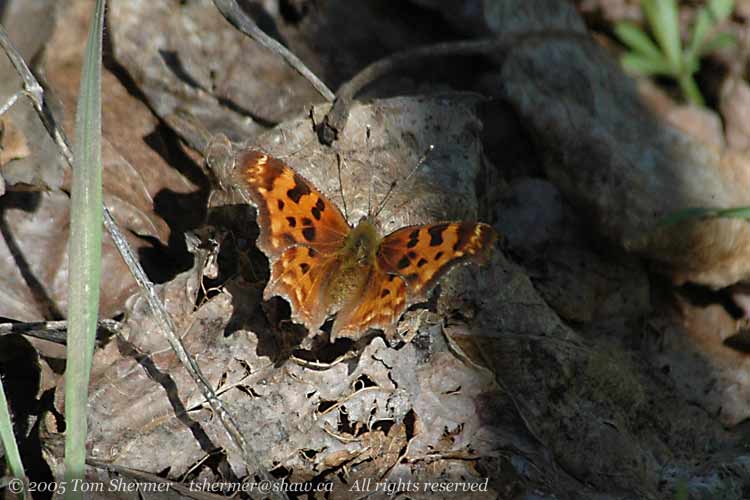 |
| While I
was getting all up-close and personal with the fluttery guy on the
leaves, I noticed this lady making her way up the nearby landscape. |
|
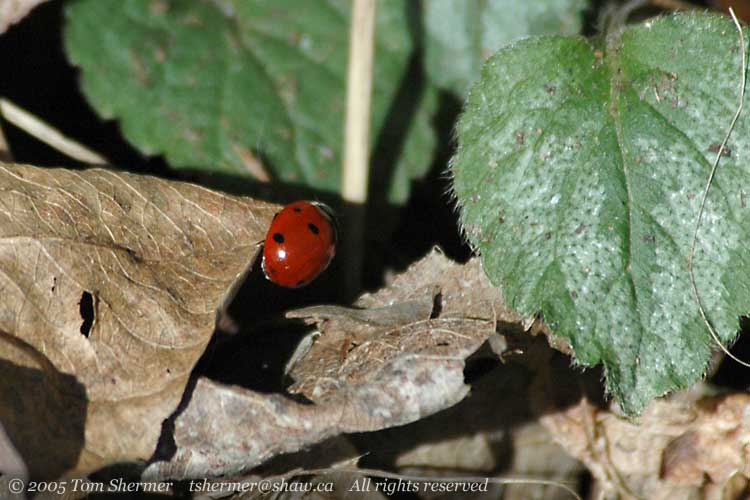 |
|
I took a few photos
of her, but then she crawled around to the other side of the leaves,
and I decided to head on rather than wait for a better shot of
her.
I made it to the dyke,
and the tide was out in the bay. This is a shot towards Mt. Baker;
the ocean might be somewhere out there. More likely it's off to
the right a bit. Either way, the tide was way out.
|
|
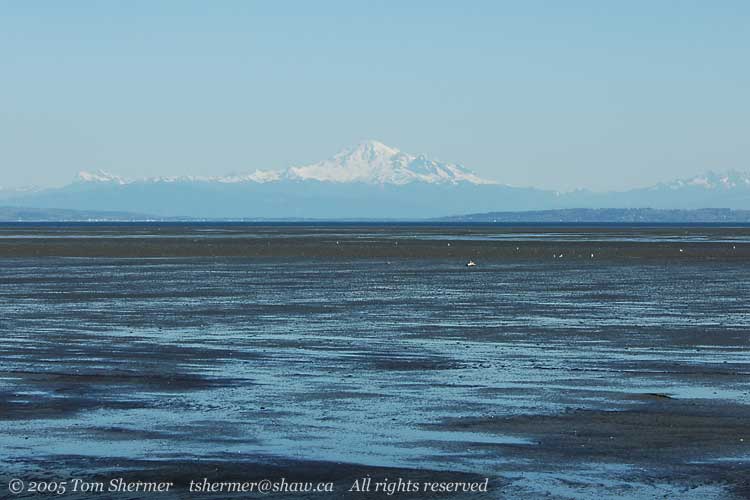 |
| I resolved
to come back some time when the tide was in, and to forgo walking
down the dyke with the bay all dried up like that. I headed back
to the wooded part of Beach Grove, and found this little guy up
in a tree. |
|
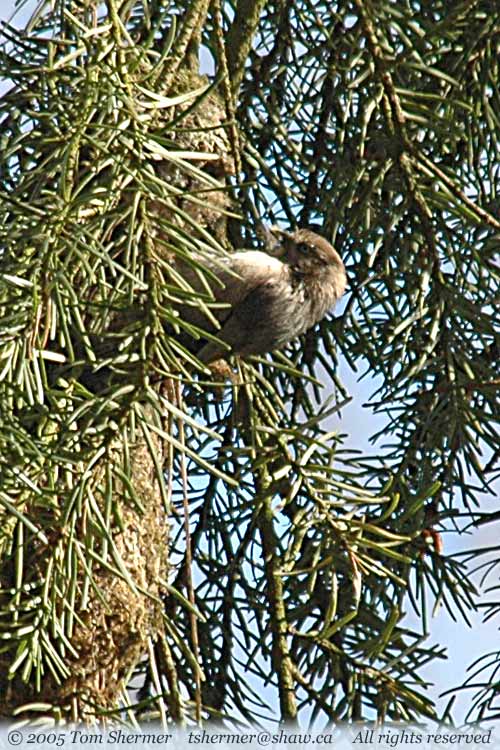 |
|
My impression in the
field was that the bird was a bushtit, but when I came home and
saw this photo, I had second thoughts. Bushtits have thin little
almost-cylindrical bills, like the tip of a ball-point pen, and
this guy looks to have a hatchet for a bill. And I couldn't find
a little bird with a hatchet bill in any of my books.
I checked with my pal
Ilya and it turns out that my first impression was correct; the
bird was a Bustit, and he's holding something in his bill (like
a seed or a "leaf" from a pinecone), and that is what
is giving the appearance of a large bill.
I heard the sound of
a woodpecker doing its thing, and after searching for a few minutes,
I found him on an old snag. The snag was right next to the trail,
so I positioned myself close to it and shot some photos pointed
almost directly up. This gave an interesting angle and a bit of
an impression of how the whole thing must appear to the guy doing
the pecking. He's a Downy Woodpecker, one of the little ones.
|
|
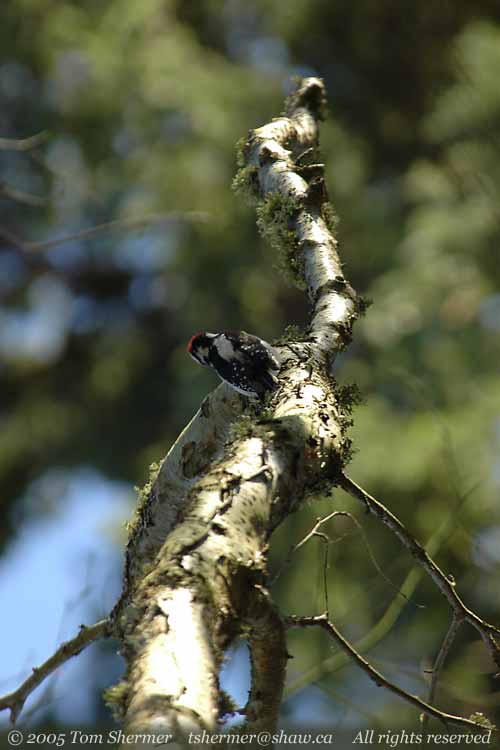 |
| While I
was gazing up, I noticed another Bushtit flitting from branch to
branch in a nearby tree. I started taking photos and got lucky—he
spread his tail, and the sun lit it up from the other side. |
|
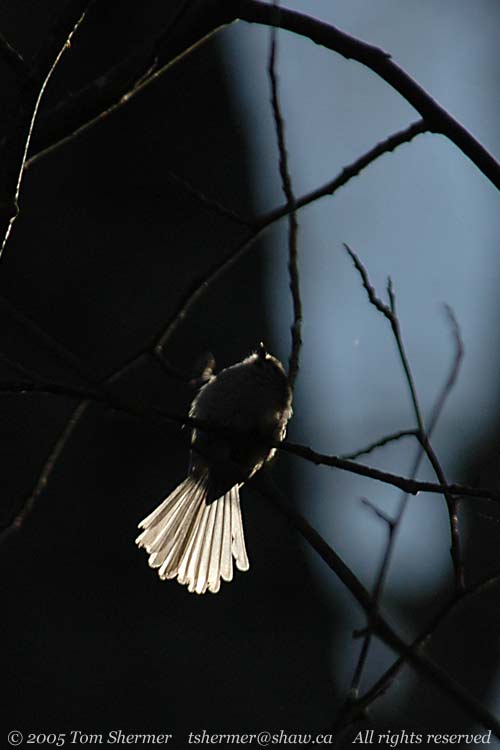 |
|
Still looking mainly
upward, I saw a Brown Creeper hopping up a tree trunk. I took
a couple of photos of him, which didn't turn out that well, and
then noticed a big bird descending into the treetops. It was an
adult Cooper's Hawk. I've never been this close to a perched adult
before, so I wasn't able to identify him in the field. Good thing
I brought my camera along.
|
|
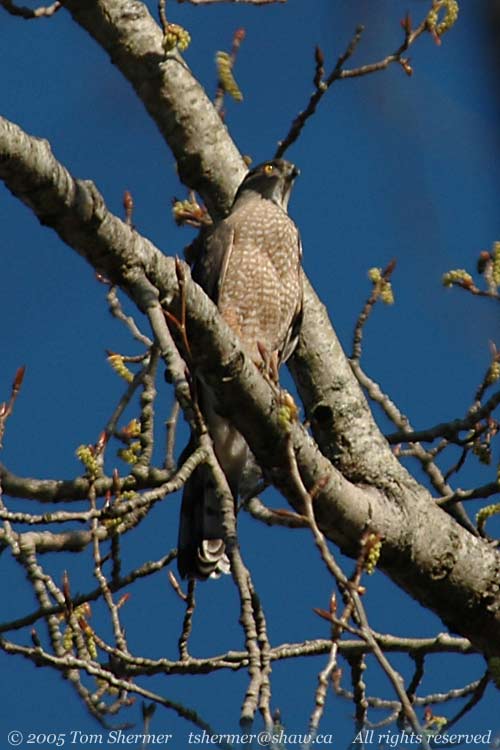 |
|
Attractive bird, that
Cooper's. I shot photos of him for as long as he stayed, which
was only about a minute and a half.
I continued through
the woodsy part of the park, and spotted a male Northern Flicker.
He paused to pose in the sunlight for me, which was awful nice
of him. I think he wanted to show off his brilliant tail. Check
out how waxy and shiny it appears.
|
|
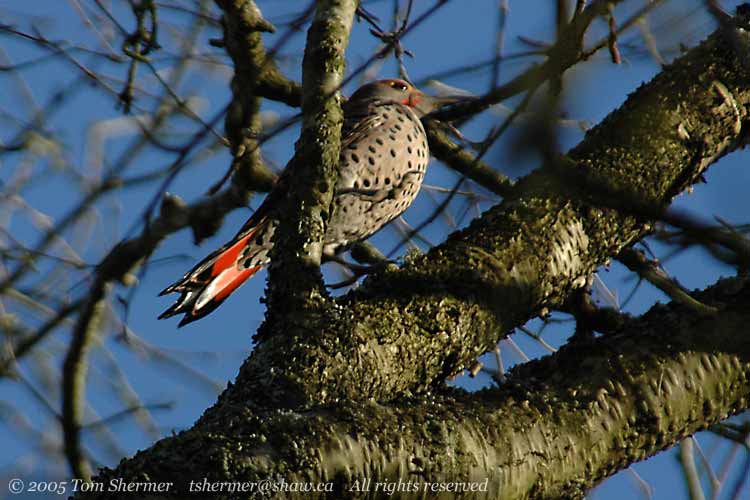 |
|
Further along, I found
this rather confused young Red-tailed Hawk. I don't think that
he got the right idea from the part in the hawk manual that says
"a perch in a tree can offer good concealment from which
to watch your prey."
|
|
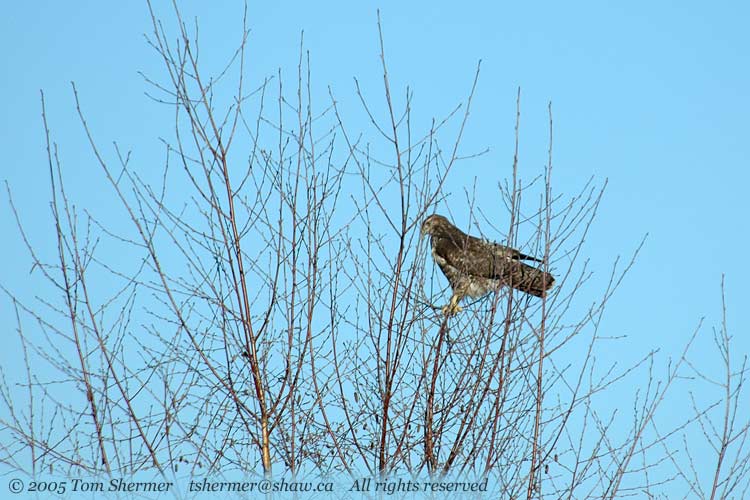 |
|
Not only that, he's
a sloppy dresser. Have a look at this close-up of him when he
took off. On his right leg (on the left in the photo), it looks
like he's wearing some loose trousers or pyjamas. On his left,
it's tights.
|
|
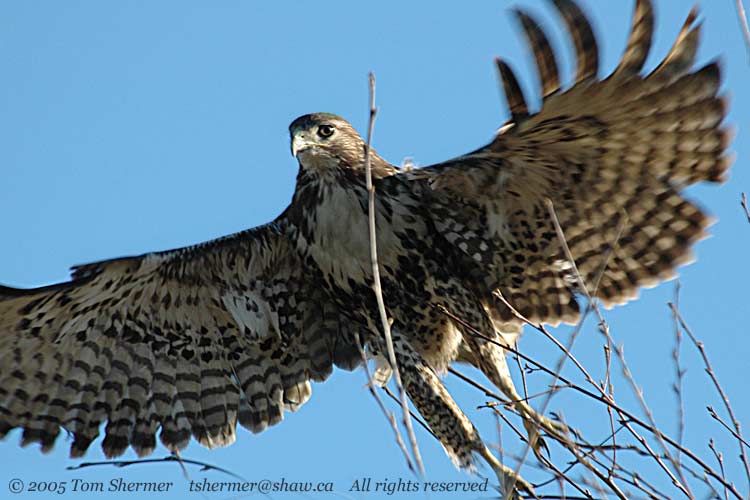 |
|
They really should've
kept that guy a few more months at the hawk academy before letting
him loose on the world.
After watching the
hapless hawk fly off, I turned back towards my car. In the small
trees near the car, I found a male Brewer's Blackbird.
|
|
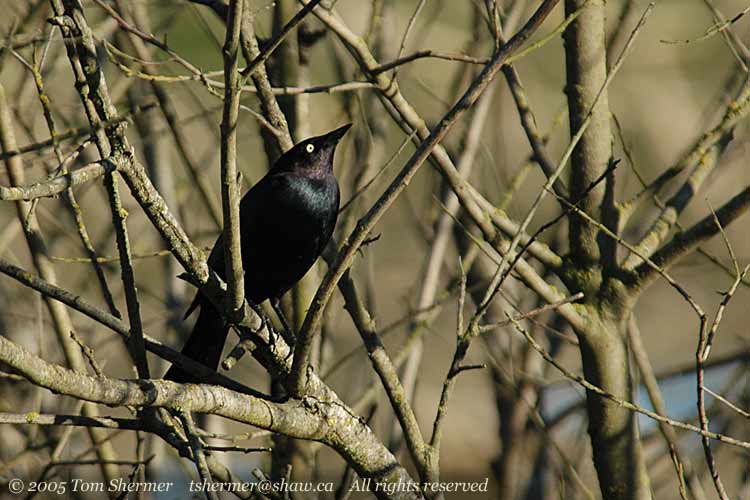 |
|
And near him was this
bird, a female Brewer's. I like the plumage pattern on her wing.
|
|
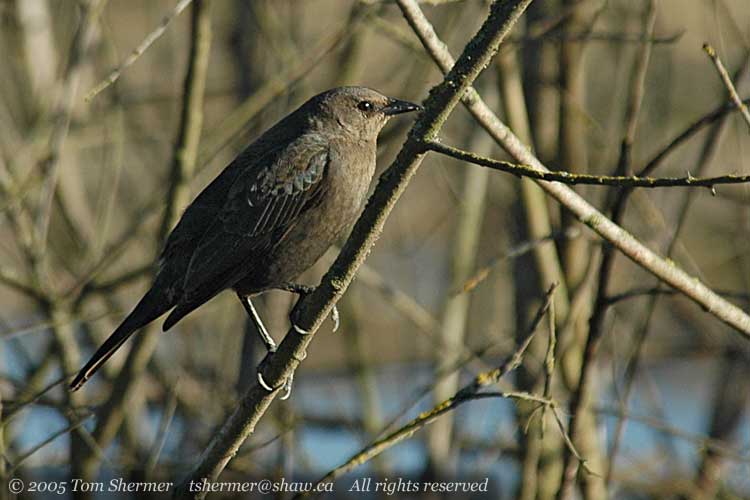 |
| That was
it for Beach Grove, and almost all of my photography for the day.
I found one more subject, Sonic, waiting for me outside my condo
when I got home. |
|
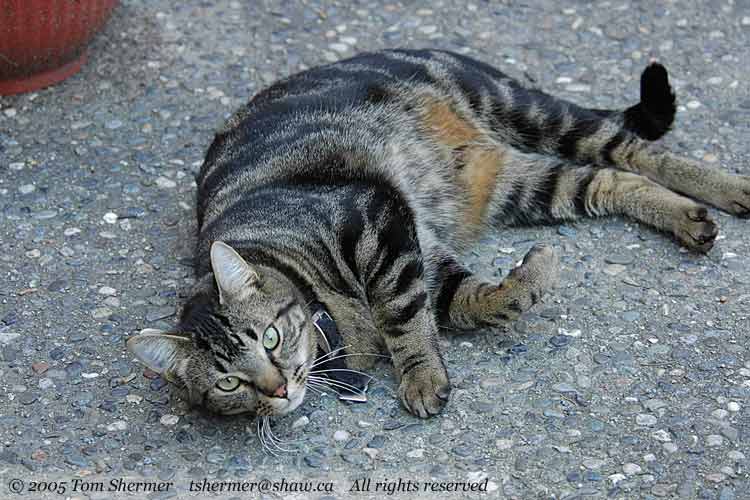 |
|
Sonic is one of my
neighbors' kitty, but he likes to enter every condo he can. I've
sometimes found him asleep in my unit during the day; the odd
thing is that most of the time my cat won't chase him out.
Curious about the ways
of kitties,
Tom
|
|